Top ratings
Get free trial access now Try first, then study!

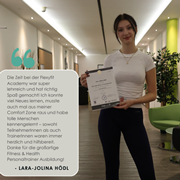
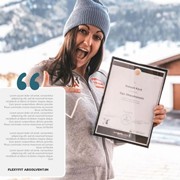

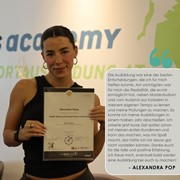
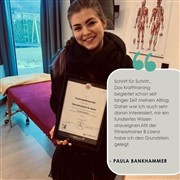
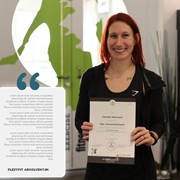
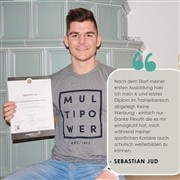
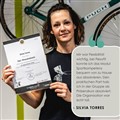


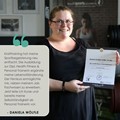

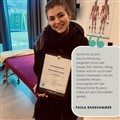

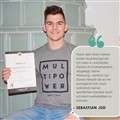

€ 798,- | Online Courses
» Our Course Packages
Important informations
Recognized & Certified
Our graduates, partners & friends say
Our team will be happy to advise you at any time by phone, chat or in person
Would you like to turn your passion into a profession and take off in the fitness sector? Then the Fitness Trainer B-License is just right for you! With this qualified fitness trainer course, you have the chance to schedule your time with flexibility and learn the subjects comfortably from home - even alongside your job or your family. In addition, the Academy provides you the possibility to be advised by expert lecturers and therefore prepare yourself for your future in the best way.
After completing the program, you will have competencies in strength training with major equipment as well as basic knowledge of anatomy, physiology, training theory and much more.
You strive for more and have the goal to work as a certified fitness trainer or even as a personal trainer? Then you can start right from the beginning with a more comprehensive program or add on to one of the advanced courses later.
So what are you waiting for? Take your chance today and sign up for a free consultation about the Fitness Trainer B-License!
Extent of learning
363 E
EQF level
The training is based on EQF level 3 »
Course start
Possible immediately
Learning variant
Online Courses
Available
Languages


Our online course for the Fitness Trainer B-Licence prepares you perfectly for a career in the sports - & health sector. Wheter you want to work as a fitness trainer in a gym or improve your own training - the Online Trainer B-Licence you sets your essential fundament in the right direction.
With the Fitnesstrainer B-Licence you have the goal to support and instruct new customers in the gym in equipment training. This ensures that every customer is very familiar with the operation and proper handling of the equipment.
Our Online-Course to the Fitness Trainer B-Licence offers you maximum freedom and flexibility. You can study independently of location and time, according to your own needs. Through our extensive scripts and numerous videos, you have access to high-quality learning material at any time. Even after completing the training, the documents will remain with you forever.
The basic module Sports Competence focuses on the anatomical, physiological and training science fundamentals. In addition, nutrition-specific topics, professional knowledge and First Aid for sports injuries are covered in the training program. A variety of videos are used to illustrate specific exercises as well as the use of fitness equipment to give you practical insights.
You want to go one step further and improve your skills in personal training? Then take a look at our distance laerning Fitness- & Personal Trainer Courses.
Our certificates are accepted worldwide and are issued in different versions. On request, you can receive our certificate in several languages (DE, EN, ES), with country-specific information as well as with and without imprint of the grades.
These versions are all available for free download from your Online-Campus. In addition, you receive a certificate of your choice printed on special paper with relief printing.
The following certificate (in several languages DE, EN, ES) is awarded:
"Fitness Trainer B-License"
We are happy to help. Contact us via phone, e-mail or online chat. Alternatively, you may find the answer to your question in our general FAQ or Fitness Trainer FAQ.
Extent of learning
200
Sports expertise
124
eLearning | Presence
6
Literature research
30
Practical realization
3
Additional tasks & examinations
Our training courses are generally eligible for funding. The relevant funding body will decide whether you are eligible for funding.
We will be happy to support you in compiling all the necessary course information you need for your funding application.
Of course, we will be on hand to advise you throughout the entire process and support you from the initial inquiry to the submission of your application. Contact us - we will make sure that you are as well prepared as possible!
Show all chapters of the subjects

We educate the best trainers in the fitness branch. From start to finish of the education - and beyond!- we support and guide our students.
Functional anatomy is a foundation necessary for all trainers in exercise, fitness and sports. This subject provides a comprehensive introduction to the anatomy of the human body and a wellspring of important knowledge.
The course is constructed to present the information in an interesting and comprehensible manner and features different learning approaches appropriate for Fitness and Personal Trainers.
The goal is, to understand the relationship between movement patterns, the human body and relevant anatomical terminology.

Our participants are introduced to the basics of sports nutrition.
As a foundation the composition of general nutrition including macro and micro nutrients, as well as the water balance, are discussed. In order to understand various correlations, the energy metabolism are explained in detail.
In addition, the effects of individual food components in the human body, as well as their importance in sports are covered.


More and more companies are integrating Corporate Wellness and similar health initiatives into their employee benefits packages. By doing so they promote the health and well-being of their employees, reducing the incidence of sick-leave and building healthier, stronger team dynamics.
Exactly why such initiatives are important is discussed in this introduction to the concept, as well as challenges that such initiatives face including organisational dysfunction.
Participants also learn about the advantages of corporate wellness and some trusted approaches and tools for finding and working with a company.
We offer suggestions on how to approach companies about Corporate Wellness, how to develop a corporate wellness concept and important organisational points to consider.
Participants will be exposed to some practical examples and will have the possiblity to perform group work on the topic.

The unit on Marketing and Customer Interaction gives participants some insight into identifying, working with and marketing to their ideal customer. This is one of the most useful units for the aspiring trainer, as it helps them identify their place in the market, which makes for a more successful career start.
We begin by taking a look at Marketing itself to understand exactly what it is and of what relevance it has for personal trainers.
Important basic concepts such as USP, positioning, target market, etc. are introduced and different models from marketing such as the SMART Formula, marketing mix (7Ps) and more are explained.
The communication between trainer and client is also addressed in this unit. Various aspects of communication theory and some guidelines for successful communication are covered.
Upon completion of this subject, participants are able to develop marketing strategies for their product and/or services, ready to position themselves in a market rich in variety and full of possibility!

A working understanding of human physiology and therefore the relationships between the various functions of the human body is crucial for anyone working in the exercise and fitness field. It is a requisite knowledge for the sufficient practice of their profession.
This course makes the relationships within the human organism graspable for everyone. Take a deep-dive into the human body and learn the functions of our organism for your new profession in fitness.
In this subject you will get a close look at energy metabolism needed for muscle activation, the circulatory system and the pulmonary system.
Any high quality education in fitness and exercise begins with the foundations of anatomy and physiology.

In this unit participants are prepared for successful communication with their clients on every level. In addition, we take a look at how the trainer or coach can go about dealing with their own goals and motives, which will in turn help them better understand their clients.
The right goal-setting and the proper approach to feedback are an important parts of this unit.
The way we manage stress as trainers and with our clients and a variety of learning strategies are explored so these skills can be integrated into your professional approach.

The first part of training theory teaches the basics of training, such as training principles, principles of training design, training methods and the factors of athletic performance.
As performance, performance diagnostics, training and competition are closely interrelated, they are also taught accordingly in the course.
In the second part of training theory, training is defined and evaluated as a complex action process and in connection with planning, execution and evaluation.
An important part of training theory is still the design of training plans, which is taught in practice with examples of the possibilities of designing a training plan.
In order to delve even deeper into training science, we have worked with top international speakers such as Prof. em. Dr. phil. Dr. med. Dr. h.c. Jürgen Weineck, we have also developed a video workshop on the subject of altitude training.
Show all chapters of the subjects

The subject "Equipment-assisted strength training" is part of the fitness trainer B license training and deals with systematic strength training on stationary training equipment. The focus is on movement control, load control and the individual adaptation of training to different target groups.
In equipment-supported strength training, the muscles are loaded via mechanically guided movement paths. This enables targeted, controlled strain on individual muscle groups and offers a safe form of training, particularly for beginners, people with restricted mobility or in a rehabilitative context.
The following topics are covered as part of the course:
The content of this subject forms a basis for practical work in fitness studios or health facilities. Graduates are able to create and instruct individual training programs with equipment and implement them in a safety-conscious manner.

Performing practical training sessions is an essential component to achieving the Fitness Trainer B-License.
Studying the anatomy of the human body, especially the muscles with origin and insertion, is an important part of the preparation for the exam. Documenting the practical sessions are just as important. A training record is used to get an overview of the performed session, the achieved goal and the personal experience of the participants.
There are 30 training units, in which the participants can put their acquired knowledge into practice. Each of these units has to be recorded by the participants on their own responsibility, so they can show that they are able to prepare, perform and evaluate a training session independently.
The Fitness Trainer B-License is one of our smaller training courses to gain basic knowledge on topics of strength training with machines, anatomy, physiology, training theory and much more. It is important to structure the training in a way that the participants understand the exercises and are able to perform them safely. For the practical sessions a guide will be provided to the participants, which they can use to write down the training record.
For the evidence of completed sessions, a written confirmation from a trainer or screenshots from a training app must be provided.
Available course variations
Language of Instruction
Course Module
Fitness Fundamentals
Fitness basics (presence)
Fitness Fundamentals Full HD Video Lessons
Full HD LearningVideos Fitness Trainer B-Lize
Included Course of Study
Course Modality
Study Method
Auditory & Visual Learning Style
Communicative & Kinesthetic Learning Style
Study Timeframe
Text & Presentation PDFs
Lectures Bookable as Classroom Units
Support via Online Campus, E-mail, Chat, Tel.
WhatsApp & On-site Support
Test/Dummy Exam
NADA Austria
Altitude Training - Prof. Dr. Weineck
Fitness Fundamentals Theory Exams Online
Final Exam
Certificate in DE, EN or ES
Certificate accepted worldwide & never expires
Lifetime Access to Online Campus
Free Demo Account / Trial Package
Certificate Copy as Downloadable PDF
Certificate with Verification via QR-Code
Financial Aid/Grant Opportunities
Paid Educational Leave (AT)
Grants for Businesses
Grants for Self-Employed Persons
Course Advising
Cost Estimate for Financial Aid Provider
Job Openings Mailing List
Comprehensive Training Opportunities
Absolute Best Price & Service Offer
EN
Online + technical discussion
Optionally bookable
314
55
B-License
online
visual
recommended
suitable
Flexible
postable
Flexible date
up to 100%
non-binding
At the Flexyfit Sports Academy, you have a wide range of options for funding your training. There are various funding programs at federal state and EU level as well as tax incentives that serve as a basis.
Please note, however, that the decision on the allocation and amount of funding is the sole responsibility of the respective funding body.
We will be happy to help you find a suitable funding body and provide you with all the course information you need to apply for funding. You must submit the application itself to the relevant funding body.
Yes, the majority of our courses are suitable for educational leave.
If you would like to continue your education without terminating your employment, you can arrange educational leave with your employer. You will be released from work for the duration of the training.
Plan your educational leave with us now! We will be happy to clarify your individual training requirements with you in a personal, non-binding consultation .
Please note that this is a general summary and it is advisable to check with the relevant bodies or authorities for further details and conditions.
Your employer's consent is essential for educational leave. You must submit the training plans issued by us, which provide for 20 hours per week for full-time educational leave or at least 10 hours per week for part-time educational leave.
In addition, you must regularly provide evidence of the progress of your training, for example through examinations or attendance certificates issued by us.
Tho roles of a fitness trainers can vary widely based on factors like whether you're employed or working independently, and where you're working.
No matter the job setup, the main focus is always improving people`s fitness. If you're working at a gym as an employee, you might also handle some administrative tasks or guide new members through the gym's setup.
As a personal trainer with a personal trainer certification your role involves analyzing the fitness level of your clients, setting goals together, creating customized workout plans, and explaining the use of strength and cardio equipment along with fitness exercises. Subsequently, you accompany your clients on their journey, provide motivation, and ensure the achievement of their goals.
If you choose the career path of a group-fitness trainer, you will lead group classes for various sports such as Pilates, yoga, or aerobics. In this case it`s advisable to undergo additional training as a Yoga instructor, Pilates trainer or group-fitness trainer to deepen your knwoledge.
The salary of a fitness trainer varies based on the type of employment. In an employment position one can expect an entry-level salary of around € 18.600 to € 21.900 gross per year. With increasing professional experience, earnings rise to approximately € 23,200 to € 25,000 annually.
For those who are self employed the income depends on the number of clients and the set prices. The cost of renting space must also be considered, unless the trainer opts for home visits and outdoor training.
Fitness trainers find employment in various fields. They often work in fitness studios, either as permanent employees or independent contractors. Additionally, they are also needed in wellness establishments such as hotels or health centers or sports clubs.
Many fitness trainers aspire to be self employed as personal trainers, leading to a variety of potential work locations. Besides having their own facilities, popular options include outdoor training or conducting home visits for clients. Some fitness trainers may also arrange agreements with fitness centers to use their facilities in exchange for rent.
Establishing a personal fitness studio has become more challenging due to growing competition. As a result, many fitness trainers opt for alternative career paths, such as corporate wellness or sports development. In the latter, they can provide consultancy for designing fitness centers, sports fields, and sports halls.
On our platform Sportkarriere we regularly post job listings from fitness studios. From there, you have the opportunity to directly apply for positions as a fitness trainer, branch manager, instructor, or studio staff member.

Our online course for the Fitness Trainer B-Licence prepares you perfectly for a career in the sports - & health sector. Wheter you want to work as a fitness trainer in a gym or improve your own training - the Online Trainer B-Licence you sets your essential fundament in the right direction.
With the Fitnesstrainer B-Licence you have the goal to support and instruct new customers in the gym in equipment training. This ensures that every customer is very familiar with the operation and proper handling of the equipment.
Our Online-Course to the Fitness Trainer B-Licence offers you maximum freedom and flexibility. You can study independently of location and time, according to your own needs. Through our extensive scripts and numerous videos, you have access to high-quality learning material at any time. Even after completing the training, the documents will remain with you forever.
The basic module Sports Competence focuses on the anatomical, physiological and training science fundamentals. In addition, nutrition-specific topics, professional knowledge and First Aid for sports injuries are covered in the training program. A variety of videos are used to illustrate specific exercises as well as the use of fitness equipment to give you practical insights.
You want to go one step further and improve your skills in personal training? Then take a look at our distance laerning Fitness- & Personal Trainer Courses.
Our certificates are accepted worldwide and are issued in different versions. On request, you can receive our certificate in several languages (DE, EN, ES), with country-specific information as well as with and without imprint of the grades.
These versions are all available for free download from your Online-Campus. In addition, you receive a certificate of your choice printed on special paper with relief printing.
The following certificate (in several languages DE, EN, ES) is awarded:
"Fitness Trainer B-License"
We are happy to help. Contact us via phone, e-mail or online chat. Alternatively, you may find the answer to your question in our general FAQ or Fitness Trainer FAQ.
Extent of learning
200
Sports expertise
124
eLearning | Presence
6
Literature research
30
Practical realization
3
Additional tasks & examinations
Our training courses are generally eligible for funding. The relevant funding body will decide whether you are eligible for funding.
We will be happy to support you in compiling all the necessary course information you need for your funding application.
Of course, we will be on hand to advise you throughout the entire process and support you from the initial inquiry to the submission of your application. Contact us - we will make sure that you are as well prepared as possible!
Show all chapters of the subjects

We educate the best trainers in the fitness branch. From start to finish of the education - and beyond!- we support and guide our students.
Functional anatomy is a foundation necessary for all trainers in exercise, fitness and sports. This subject provides a comprehensive introduction to the anatomy of the human body and a wellspring of important knowledge.
The course is constructed to present the information in an interesting and comprehensible manner and features different learning approaches appropriate for Fitness and Personal Trainers.
The goal is, to understand the relationship between movement patterns, the human body and relevant anatomical terminology.

Our participants are introduced to the basics of sports nutrition.
As a foundation the composition of general nutrition including macro and micro nutrients, as well as the water balance, are discussed. In order to understand various correlations, the energy metabolism are explained in detail.
In addition, the effects of individual food components in the human body, as well as their importance in sports are covered.


More and more companies are integrating Corporate Wellness and similar health initiatives into their employee benefits packages. By doing so they promote the health and well-being of their employees, reducing the incidence of sick-leave and building healthier, stronger team dynamics.
Exactly why such initiatives are important is discussed in this introduction to the concept, as well as challenges that such initiatives face including organisational dysfunction.
Participants also learn about the advantages of corporate wellness and some trusted approaches and tools for finding and working with a company.
We offer suggestions on how to approach companies about Corporate Wellness, how to develop a corporate wellness concept and important organisational points to consider.
Participants will be exposed to some practical examples and will have the possiblity to perform group work on the topic.

The unit on Marketing and Customer Interaction gives participants some insight into identifying, working with and marketing to their ideal customer. This is one of the most useful units for the aspiring trainer, as it helps them identify their place in the market, which makes for a more successful career start.
We begin by taking a look at Marketing itself to understand exactly what it is and of what relevance it has for personal trainers.
Important basic concepts such as USP, positioning, target market, etc. are introduced and different models from marketing such as the SMART Formula, marketing mix (7Ps) and more are explained.
The communication between trainer and client is also addressed in this unit. Various aspects of communication theory and some guidelines for successful communication are covered.
Upon completion of this subject, participants are able to develop marketing strategies for their product and/or services, ready to position themselves in a market rich in variety and full of possibility!

A working understanding of human physiology and therefore the relationships between the various functions of the human body is crucial for anyone working in the exercise and fitness field. It is a requisite knowledge for the sufficient practice of their profession.
This course makes the relationships within the human organism graspable for everyone. Take a deep-dive into the human body and learn the functions of our organism for your new profession in fitness.
In this subject you will get a close look at energy metabolism needed for muscle activation, the circulatory system and the pulmonary system.
Any high quality education in fitness and exercise begins with the foundations of anatomy and physiology.

In this unit participants are prepared for successful communication with their clients on every level. In addition, we take a look at how the trainer or coach can go about dealing with their own goals and motives, which will in turn help them better understand their clients.
The right goal-setting and the proper approach to feedback are an important parts of this unit.
The way we manage stress as trainers and with our clients and a variety of learning strategies are explored so these skills can be integrated into your professional approach.

The first part of training theory teaches the basics of training, such as training principles, principles of training design, training methods and the factors of athletic performance.
As performance, performance diagnostics, training and competition are closely interrelated, they are also taught accordingly in the course.
In the second part of training theory, training is defined and evaluated as a complex action process and in connection with planning, execution and evaluation.
An important part of training theory is still the design of training plans, which is taught in practice with examples of the possibilities of designing a training plan.
In order to delve even deeper into training science, we have worked with top international speakers such as Prof. em. Dr. phil. Dr. med. Dr. h.c. Jürgen Weineck, we have also developed a video workshop on the subject of altitude training.
Show all chapters of the subjects

The subject "Equipment-assisted strength training" is part of the fitness trainer B license training and deals with systematic strength training on stationary training equipment. The focus is on movement control, load control and the individual adaptation of training to different target groups.
In equipment-supported strength training, the muscles are loaded via mechanically guided movement paths. This enables targeted, controlled strain on individual muscle groups and offers a safe form of training, particularly for beginners, people with restricted mobility or in a rehabilitative context.
The following topics are covered as part of the course:
The content of this subject forms a basis for practical work in fitness studios or health facilities. Graduates are able to create and instruct individual training programs with equipment and implement them in a safety-conscious manner.

Performing practical training sessions is an essential component to achieving the Fitness Trainer B-License.
Studying the anatomy of the human body, especially the muscles with origin and insertion, is an important part of the preparation for the exam. Documenting the practical sessions are just as important. A training record is used to get an overview of the performed session, the achieved goal and the personal experience of the participants.
There are 30 training units, in which the participants can put their acquired knowledge into practice. Each of these units has to be recorded by the participants on their own responsibility, so they can show that they are able to prepare, perform and evaluate a training session independently.
The Fitness Trainer B-License is one of our smaller training courses to gain basic knowledge on topics of strength training with machines, anatomy, physiology, training theory and much more. It is important to structure the training in a way that the participants understand the exercises and are able to perform them safely. For the practical sessions a guide will be provided to the participants, which they can use to write down the training record.
For the evidence of completed sessions, a written confirmation from a trainer or screenshots from a training app must be provided.
Available course variations
Language of Instruction
Course Module
Fitness Fundamentals
Fitness basics (presence)
Fitness Fundamentals Full HD Video Lessons
Full HD LearningVideos Fitness Trainer B-Lize
Included Course of Study
Course Modality
Study Method
Auditory & Visual Learning Style
Communicative & Kinesthetic Learning Style
Study Timeframe
Text & Presentation PDFs
Lectures Bookable as Classroom Units
Support via Online Campus, E-mail, Chat, Tel.
WhatsApp & On-site Support
Test/Dummy Exam
NADA Austria
Altitude Training - Prof. Dr. Weineck
Fitness Fundamentals Theory Exams Online
Final Exam
Certificate in DE, EN or ES
Certificate accepted worldwide & never expires
Lifetime Access to Online Campus
Free Demo Account / Trial Package
Certificate Copy as Downloadable PDF
Certificate with Verification via QR-Code
Financial Aid/Grant Opportunities
Paid Educational Leave (AT)
Grants for Businesses
Grants for Self-Employed Persons
Course Advising
Cost Estimate for Financial Aid Provider
Job Openings Mailing List
Comprehensive Training Opportunities
Absolute Best Price & Service Offer
EN
Online + technical discussion
Optionally bookable
314
55
B-License
online
visual
recommended
suitable
Flexible
postable
Flexible date
up to 100%
non-binding
At the Flexyfit Sports Academy, you have a wide range of options for funding your training. There are various funding programs at federal state and EU level as well as tax incentives that serve as a basis.
Please note, however, that the decision on the allocation and amount of funding is the sole responsibility of the respective funding body.
We will be happy to help you find a suitable funding body and provide you with all the course information you need to apply for funding. You must submit the application itself to the relevant funding body.
Yes, the majority of our courses are suitable for educational leave.
If you would like to continue your education without terminating your employment, you can arrange educational leave with your employer. You will be released from work for the duration of the training.
Plan your educational leave with us now! We will be happy to clarify your individual training requirements with you in a personal, non-binding consultation .
Please note that this is a general summary and it is advisable to check with the relevant bodies or authorities for further details and conditions.
Your employer's consent is essential for educational leave. You must submit the training plans issued by us, which provide for 20 hours per week for full-time educational leave or at least 10 hours per week for part-time educational leave.
In addition, you must regularly provide evidence of the progress of your training, for example through examinations or attendance certificates issued by us.
Tho roles of a fitness trainers can vary widely based on factors like whether you're employed or working independently, and where you're working.
No matter the job setup, the main focus is always improving people`s fitness. If you're working at a gym as an employee, you might also handle some administrative tasks or guide new members through the gym's setup.
As a personal trainer with a personal trainer certification your role involves analyzing the fitness level of your clients, setting goals together, creating customized workout plans, and explaining the use of strength and cardio equipment along with fitness exercises. Subsequently, you accompany your clients on their journey, provide motivation, and ensure the achievement of their goals.
If you choose the career path of a group-fitness trainer, you will lead group classes for various sports such as Pilates, yoga, or aerobics. In this case it`s advisable to undergo additional training as a Yoga instructor, Pilates trainer or group-fitness trainer to deepen your knwoledge.
The salary of a fitness trainer varies based on the type of employment. In an employment position one can expect an entry-level salary of around € 18.600 to € 21.900 gross per year. With increasing professional experience, earnings rise to approximately € 23,200 to € 25,000 annually.
For those who are self employed the income depends on the number of clients and the set prices. The cost of renting space must also be considered, unless the trainer opts for home visits and outdoor training.
Fitness trainers find employment in various fields. They often work in fitness studios, either as permanent employees or independent contractors. Additionally, they are also needed in wellness establishments such as hotels or health centers or sports clubs.
Many fitness trainers aspire to be self employed as personal trainers, leading to a variety of potential work locations. Besides having their own facilities, popular options include outdoor training or conducting home visits for clients. Some fitness trainers may also arrange agreements with fitness centers to use their facilities in exchange for rent.
Establishing a personal fitness studio has become more challenging due to growing competition. As a result, many fitness trainers opt for alternative career paths, such as corporate wellness or sports development. In the latter, they can provide consultancy for designing fitness centers, sports fields, and sports halls.
On our platform Sportkarriere we regularly post job listings from fitness studios. From there, you have the opportunity to directly apply for positions as a fitness trainer, branch manager, instructor, or studio staff member.

2 weeks ago
Very well organized team, uncomplicated operation of online lessons, versatile informative script :) All in all top!
posted on
2 weeks ago
I am very impressed with Flexyfit, always nice and helpful people. Very sympathetic. Thank you very much for your great support.
posted on
3 weeks ago
Great training and super nice people. You can tell how much emphasis is placed on conveying the necessary knowledge to the course participants in an understandable way. I was even kindly allowed to take a course completely free of charge after there were somewhat problematic and disruptive participants in my group. I will 100% take more courses with you in the future because learning is extremely fun, especially thanks to the friendly staff!
posted on
3 weeks ago
The entire flexyfit team is extremely friendly, prompt and helpful. The lecturers are competent and respond to the course participants. All learning materials were provided clearly and in sufficient detail. The additional videos mean there is something for every type of learner. All in all, the training and exam went well. I can definitely recommend flexyfit and will be happy to book and recommend further training courses with you again!
posted on
a months ago
A great team - competent, friendly, always helpful and supportive - provided excellent support for the practical training. We recommend! :)
posted on
a months ago
Great support and extensive course content. We recommend!
posted on
a months ago
I really enjoyed training to become a B-license fitness trainer there. The teaching materials provided are great and flawless. I learned a lot of new things there and always enjoyed what I was doing. The team is great and is always there for you if you have any questions!
posted on
a month ago
The best thing that could have happened to me is this academy. Access to participants is excellent. All employees are very competent, very professional and very friendly. A person can learn so much that it is indescribably good. I would recommend it to everyone. When I arrived in Austria I was looking for something like this and luckily I found this academy and signed up for the course without hesitation. Everything we get in return is worth 100 times more than what we pay. Indescribable experience, indescribable people, once again and 1000 times I say: Thank you for everything, thank you for this indescribable experience. THANK YOU, THANK YOU, THANK YOU
posted on
a months ago
I was able to learn a lot of new things as part of my training at the Flexyfit Academy and was able to take on a new, demanding challenge with my chosen course. The structure of the training courses is very understandable and clear, so that you can master the distance learning course on your own without any problems. If there were any questions, ambiguities or isolated problems, the Academy team was always quick to help and we could always find a common solution. Here and there I would have liked a little more practical relevance. Nevertheless, I always felt very comfortable, had great speakers and with my degree as a qualified medical sports coach, many new doors are now open to me :)
posted on
2 months ago
I was able to complete my chosen course very well and quickly. The team is very quick and courteous and you are always offered a good solution if there are any uncertainties. I will book again when I get the chance and can recommend the academy!
posted on
"Flexyfit - flexible learning, fit for the future."

Please select a learning variant or enter a search text!